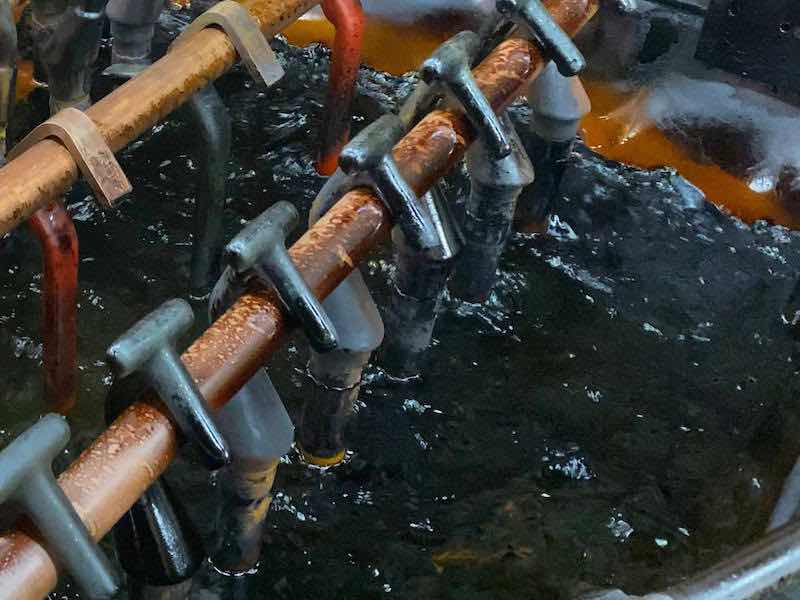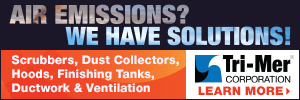An impurity is anything in the bath other than pure water and the desired chemicals.
 Eric Svenson, Sr.All impurities have a detrimental effect, some much worse than others. Compared to other plating processes, hexavalent hard chrome baths are reasonably tolerant to a broad range of impurities.
Eric Svenson, Sr.All impurities have a detrimental effect, some much worse than others. Compared to other plating processes, hexavalent hard chrome baths are reasonably tolerant to a broad range of impurities.
This does not mean impurities can be ignored because they cause expensive problems when their levels are above recommended limits.
Typical Impurities
The most common hex-chrome bath impurities are excessive trivalent chrome, iron, copper, and chloride. Each will be discussed individually because it is important to understand the mechanisms involved with each of these.
Trivalent Chrome
Trivalent chrome is generated in a number of ways, and it should always be kept below a maximum 3% level (as a percentage of the chromic acid present). Ideally, the trivalent should be maintained at a 1% level. It is produced naturally at the cathode during plating, where it is then reduced back to hexavalent chromic acid at an active anode surface. The trivalent concentration will maintain itself at the recommended 1% level only when:
- The ideal anode-cathode ratio of 2:1 is used
- The anode is making electrical contact and is not heavily scaled
- It has the desired blackish lead peroxide film.
Maintaining the ideal anode ratio is not usually a problem with OD plating, but a 2:1 ratio is impossible when plating ID surfaces. Trivalent is also generated whenever a metal is dissolved, like in reverse etching or when an organic is introduced into the bath.
Iron
Typically, the main source of iron is from reverse etching in the plating bath or if a steel anode is used. It can also be introduced by improper stop-off of unplated areas and from bare steel fixtures. By itself, the iron level should be kept below 5 g/l and less than this if other impurities are present. Iron levels can be maintained below 1.0 g/l for longer than ten years in systems utilizing a separate reverse etch tank. Conversely, the iron level can exceed 7 g/l in the first year of operation if a separate reverse tank is not used or if the other precautions are ignored.
Copper
Copper is typically introduced from chrome misting on the buss bars, from plating copper or copper alloy parts, and sometimes from the fixturing. By itself, the copper level should be kept below 2 g/l and less than this if other impurities are present. Copper is a significantly more powerful impurity than either trivalent or iron.
Chloride
Chloride is an extremely powerful ion that acts like an excessive catalyst in chrome baths. Its maximum concentration is only 50 ppm but should be maintained below 20 ppm. Levels above 50 ppm cause dullness, burning, roughness, reduced throwing power, and slower plating speeds. Typical sources of chloride are drag-in from a hydrochloric acid stripper or from the water supply itself. Small amounts of chloride evolve naturally at the anode surface during plating. This normally keeps the level sufficiently low unless the chloride level is excessive.
Total Contaminant Loading
An excellent way to evaluate the impurity health of the chrome bath is the units of TCL. This is simply the sum of the percent trivalent plus the g/l of iron and copper present. A bath will never have zero impurities, even when freshly made, as there are minimal impurities present in the chemicals and frequently in the water used. During operation, these impurities increase in concentration at a rate determined by the system design, the chemicals used, and the techniques employed.
A hard chrome bath produces acceptable deposits with up to a 7.2 TCL level. Above this, a degradation of the plating quality and increased operating costs will be noticed. Therefore, it is recommended the TCL always be controlled to a maximum level of 7.2.
Amazingly a 1,000-gallon bath with metallic impurities at a 10 g/l (or a 10 TCL if it’s all iron and copper) equates to 83 pounds of tramp metals dissolved in the plating bath. It is no wonder this operation experiences ongoing quality problems, increased rework rates, and high operational costs.
High impurity levels become obvious by simply observing the color of the chromic acid bath. A relatively pure bath will be bright red in color, while a contaminated bath takes on a darker color as the TCL increases. The higher the TCL, the darker it becomes, first turning a brownish color which eventually becomes almost black. This can also be observed in the coloration of the gas bubbles generated at the solution level.
Effect of High Impurities
As a group, chrome bath impurities cause slow plating speeds, limit the current density range and cause roughness, burning, pitting, poor throwing power, brittleness, macro-cracking, poor adhesion, and excessive deposit stress. They also increase the rework, electrical consumption, and operational costs. The degree of these problems is dependent on their concentration and the TCL. Contaminated baths do not provide the degree of quality that is required in today’s business environment.
The benefits of maintaining a relatively pure plating bath (between a 4.8 – 7.2 TCL) include reduced labor and chemical costs, fewer rejects and rework, and much lower electrical costs. In addition, this avoids the very high cost of having to dispose of and remake the bath.
Cost of High Impurities
An example of high costs from operating a contaminated bath is a 2,000-gallon chrome tank plating hydraulic rods at 5,000 amperes on a single eight-hour shift having a 15.3 TCL index accumulated over seven years:
Additional Electricity (10 vs. 6 volts): 32,609
Slower Plating Speeds (lost production): 235,243
Stripping and Rework: 174,852
Lost Market Share unknown
> $ 442,704 / year
This company had no idea bath impurities were costing them that much. To make matters worse, their cost increases as the TCL continues to expand. This could have been avoided for a tenth of the cost by maintaining the TCL below 7.2 using the recommended purification method outlined.
Impurity Removal
Studies have shown that the fastest and least costly method of removing heavy metal impurities is by decanting the bath. Yes, it’s old-school technology, but it works extremely well without the need to maintain any high-priced equipment.
Other removal methods like ion exchange, membrane electrodialysis, and porous pots are either overly expensive, difficult, and costly to maintain or simply not effective in removing iron and copper. The reason decanting is chosen is because it has proven to be the most economical and practical way to control these impurities.
The recommended procedure for controlling the TCL in hex-hard chrome baths is as follows:
- Monitor the bath with periodic analysis to determine the impurity TCL. It should be treated when it reaches a level of 7.2 and purified to a level of 4.8. Maintaining it between a 4.8 and 7.2 TCL provides high-quality chrome deposits with the least amount of rework and the lowest overall cost.
- Use the electrolytic treatment known as dummying to first reduce the excess trivalent and chloride to their recommended levels of 1% and 20 PPM, respectively. Dummying prior to decanting reduces the volume of the bath that needs removal and is, therefore, the most economical approach. A separate dummy tank should be used in operations where the trivalent build-up rate is excessive. Making a 1-2% by-volume addition of CR-3 Reducer before dummying increases the trivalent reduction efficiency and significantly lowers the time and electrical energy required. Use a dummy cell having a conforming anode with a 30:1 ratio to lower the dummy time needed. This also significantly increases the reduction efficiency; it is common to use several of these with as high a DC current as possible without overheating things. Using round tank anodes (the stick type) rarely works well for this because of their small surface area. The dummying time needed is dependent on several factors, one being the level of impurities present. As an example, it typically requires 12 hours of dummying to remove 1% trivalent and 50 ppm of chloride. Using as high a DC current and temperature as possible with several dummy cells and adequate bath agitation will optimize the dummy time required. As a side note, it takes longer to reduce the trivalent from 2% to 1% than it does from, say 5% to 4%, i.e., the lower trivalent percentages require more dummying time than the higher percentages do. Contact Plating Resources, Inc. for additional information on optimizing the dummy conditions.
- The bath should now be decanted to a 4.8 TCL level when the dummying treatment has been completed. A licensed waste hauler is typically used to pump out a predetermined volume of the bath. They will be responsible for its safe and legal disposal. Depending on the amount of trivalent and heavy metals present, it is typical that only a third of the bath, or less, needs removal and remaking. The initial decanting is usually the most expensive; future decanting for impurity maintenance is typically much less costly. Overall, it is still a good investment in quality improvement and operational cost reduction.
- Remake the volume of the bath that was removed and top it off with fresh water to the desired solution level. The purified bath is now ready for continued use providing high-quality hard chrome deposits.
Notes
- Plating Resources, Inc. has a special program available that calculates the dummy time necessary, the volume of bath that needs decanting, and the quantity of chemicals required for remaking it.
- Maintaining the TCL between 4.8 and 7.2 has been shown to optimize both the plating quality and production costs. There is little economic value to lowering the TCL below 4.8 as this only increases costs without any significant gain. However, operations plating critical parts where only the highest deposit quality is acceptable should maintain their TCL values between 3.0 and 4.5.
- In some cases, increasing the chromic acid level (within limits) can act as a crutch in situations where the dummying and decanting cannot be immediately done.
- Adding 2 – 3 oz/gallon of Dura-76 Additive buffers the bath and helps improve operations where impurity build-up and its negative effects are problematic. Besides buffering, the Dura-76 Additive also tends to chelate excessive iron, copper, and trivalent impurities.
Other Impurities
Other metallic impurities that are sometimes bothersome include aluminum, nickel, tin, and zinc. However, the chrome bath has a much higher tolerance level to them, and these metals are not encountered as often. Although there are always exceptions, these do not normally build up to levels high enough to cause problems.
Oils and organics, including some fume suppressants, are also impurities as they break down to form excessive trivalent chrome and often form scum on the bath surface that can cause poor adhesion and skip plating.
Particulate matter, both magnetic and non-magnetic, should be prevented from entering the plating bath. This includes metallic debris from machining operations that are not cleaned from unplated areas.
Plant air containing oils and abrasive debris from machining and polishing operations also causes bath contamination. The plating area should be separate from any machining operation and have its own air supply. Any oils or metallics in the air break down in the chrome bath to form trivalent and typically iron impurities. Abrasive debris in the bath often causes roughness and pitting in the chrome deposit.
Excess sulfate and fluoride are also considered impurities as these upset the catalyst ratio. Of these, excess sulfate is the most problematic. The sulfate level never decreases in the chrome bath absent an overflow or a tank leak; it only increases in concentration. Typical sources for excess sulfate are chromic acid and the water supply being used. Fortunately, excess sulfate can be reduced with a barium carbonate treatment, but this is both messy and time-consuming.
Testing for Impurities
We cannot stop all impurities from entering the chrome bath; we can only control their entry, monitor them, and purify the bath when they become excessive. This requires periodic bath analysis to determine and track the impurity levels. A monthly bath analysis program is typically recommended depending on the tank size and the amount of plating being done. This will vary depending upon the number of ampere-hours per gallon of bath.
Representative bath samples should only be tested by a qualified laboratory that is familiar with hard chrome bath chemistry and is also able to make the appropriate recommendations. The cost of this analysis is repaid many times over by the higher quality, reduced rework, and lower electrical and operational costs. It simply becomes part of the quality and cost-saving program.
System Upgrades
The hard chrome industry is currently undergoing considerable change. On the one hand, environmentalists are constantly attacking chrome, and on the other hand, the industry is increasingly demanding improved product quality and faster deliveries. This indicates that only the most efficient chroming operations will survive and prosper.
The environmental situation can be managed by using the Zero Discharge approach combined with Sustainable Hard Chrome Technology. This leaves the quality and delivery issues that are best addressed by using the most efficient plating chemistry available and maintaining the baths within the recommended TCL points. This should not be looked at as an expense but from a cost reduction, increased efficiency, and quality enhancement standpoint.
Forward-looking operations should also have their equipment and processes evaluated and possibly re-engineered to the highest level of efficiency and environmental protection available while adopting the Sustainable Hard Chrome approach.
Depending upon the operation, this may require, among others, relocating the copper buss bars above the ventilation hood inlets, different tank and plating cell configurations, installing ventilation side baffles, and using the triple catalyst bath for maximum efficiency and quality.
More detailed information on bath impurities, how to control them, and recommended shop modifications for Sustainable Hard Chrome Plating are available from Plating Resources, Inc. Please contact the author at PlatingResources@yahoo.com with any comments or questions on this information. www.Plating.com

































